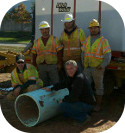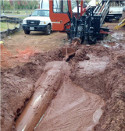
Matt Martin of Woodlawn Construction and Sam Burns of Ditch Witch of Virginia showcasing the 20-inch Underground Solutions Inc. PVC casing pipe with the Woodlawn Construction drill crew.

The 190 horsepower Cummins diesel engine Ditch Witch JT4020 AT pulled back the two pipes with ease. The 20-inch casing pipe pullback through solid rock took approximately 6 hours while the 16-inch carrier pipe pullback inside the casing pipe was finished in 2 hours.
Loudoun Water in Loudoun County, Va., saw a money making opportunity in treated wastewater that was untapped. A large customer base in the market for reclaimed water to cool data centers economically seemed like the perfect project for the Broad Run Water Reclamation Facility. But, how do you put a 16-inch carrier pipe into a 20-inch casing pipe in 870 feet of solid rock, with limited accessibility, around a crowded intersection of busy Loudoun County, and without disturbing a historic biking trail when digging a ditch or trenching won’t work? The underground trenchless solution: the right pipe, the right contractor and the right machine.
Woodlawn Construction began directionally drilling rock-installing telecommunications systems-with the help of Ditch Witch of Virginia in 1999. Woodlawn owner Phillip Staples purchased a third Ditch Witch rock directional drill in early 2012 for a difficult project outside Leesburg, Va. This 860-foot bore went under Goose Creek in solid blue stone rock, but was not a problem for the Ditch Witch JT4020 All Terrain directional drill or the experienced Woodlawn crew led by drill foreman Matt Martin. After the Goose Creek job, Woodlawn searched for bores in increased length and diameter to utilize the JT4020 AT to full potential. The dual pipe, water reclaim rock job for Loudoun Water presented the ideal challenge.
Making the Most of Water
The 870-foot bore by Woodlawn Construction is part of an ongoing initiative by Loudoun Water to build a reuse water distribution system. To date, some 21,000 feet of 12-inch and 16-inch reclaimed water mains are in place. Other existing pieces of the system were installed by traditional trench excavation with road crossings by jack and bore. Loudoun Water faced challenges with this particular stretch of pipe, including limited work area, a bike trail crossing, an active roadway, solid rock and the difficult task of pulling two pipes. The Ditch Witch JT4020 AT “machine sealed the deal with trenchless feasibility,” said Ralph Welliver, project engineer of Loudoun Water. Normally 80,000-100,000 pound pull back class drills bore water reclaims, but the small footprint and the 40,000 pound pull back of the JT4020 AT was ideal for the narrow jobsite. With high drilling torque and unique rod-within-rod technology, the Ditch Witch JT4020 AT drills and steers simultaneously through rock, performing the same bores as larger class drills.
“Reclaimed water is interesting, yet it has the same constructability properties as any pressure utility, such as sewer or water,” Welliver explained. However, reclaim water jobs are relatively new to Virginia since the enabling regulation went into effect in October 2008. Seven utilities are now pursuing reclaimed water in Virginia, while other water-sensitive areas have been using reclaimed water for some years. “It has taken a while for municipalities to get geared up for these projects. It takes the right customer base to make reclaimed water cost effective,“ said Liz Sitter, project engineer at Loudoun Water.
The Broad Run Water Reclamation Facility is an advanced treatment plant, placed into service in 2007 with the objective of producing the cleanest water possible. Broad Run, like many wastewater plants in Virginia, must follow nutrient restrictions in discharged water to avoid overloading the Chesapeake Bay and degrading the ecosystem. The reclaimed water system is a way to manage the “nutrient budget of wastewater. It also functions as a demand management tool for drinking water,” said Welliver. The county is profiting from wastewater that would otherwise be discharged. “One gallon we don’t put back is one gallon we don’t pull from the Potomac River,” Welliver stated.
Reclaimed water is not to be confused with grey water. Grey water is the practice of collecting non-potable water, typically from sink drains, and using it at the same building for irrigation or flushing of commodes. The quality of reclaimed water is much higher because it is treated to specific quality levels in the wastewater plant.
A Market for Reclaimed Water
Data centers in Loudoun County make an ideal customer base for a reclaimed water project, as connections to potable and reclaimed water mains provide valuable redundancy and reliability of supply. Currently, an average of 60,000 gallons/day from the completed reclaim water mains is used for irrigation, flushing and cooling. The bored section of the project loop Woodlawn Construction completed will bring approximately 1 million gallons/day to serve more prospective customers. Significant savings are realized in reclaimed water, as the cost per gallon is substantially less than the cost per gallon of potable water.
Two pipes at 870 feet each would appear as an added expense to the job, but actually were an important part of the cost savings. A separate casing pipe was required by the Northern Virginia Regional Park Authority, owners of the 45-mile multi-use Washington & Old Dominion rail-trail. The carrier and casing pipe requirement raised concern of material costs and jobsite costs with HDPE pipe. While HDPE had been the norm in the water and sewer industry, PVC is 2.5 times stronger in tension and thus smaller in diameter than HDPE.
Underground Solutions Inc. became an integral part of the project because the company not only made fusible, gasket-free and leak-free PVC pipe, but also offered the carrier pipe in purple, the mandated pipe color for reclaim water in Virginia. Add to the mix the bore was “going through solid rock and would have been cost prohibitive with larger diameter HDPE,” commented Gary Shepherd, southeast regional sales manager for Underground Solutions Inc. Pulling a PVC carrier pipe with a 17.4-inch outer diameter and a PVC casing pipe of 22-inch outer diameter incurred less expense per foot, and less fluid and material costs, than pulling HDPE pipes of 22-inch outer diameter and 30-inch outer diameter, respectively.
‘Show of Muscle’
The 190 horsepower Cummins diesel engine JT4020 AT pulled back the two pipes with ease. The 20-inch casing pipe pullback through solid rock took approximately 6 hours while the 16-inch carrier pipe pullback inside the casing pipe was finished in 2 hours. For the small footprint, “the power of the machine is outstanding. The show of muscle was its ability to go through the rock,” Shepherd said.
“Woodlawn Construction stayed on schedule and performed within budget,” Welliver said. The installation was deemed a success given the length and use of both casing and carrier pipes.
“We’re proud of the job from our pipe standpoint. That’s for sure,” Shepherd said.
And, for Woodlawn Construction, “having this [Ditch Witch JT4020 AT] machine made it possible,” Welliver supported.




Report Abusive Comment